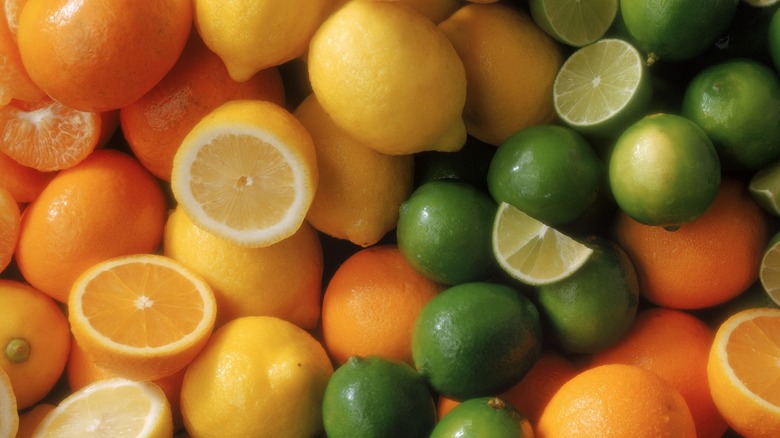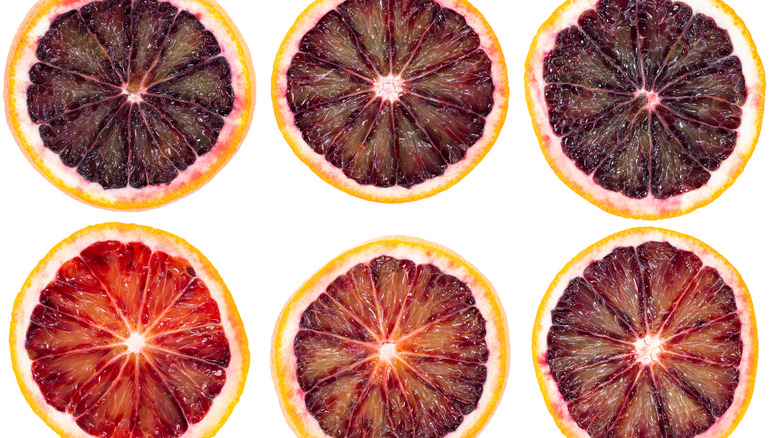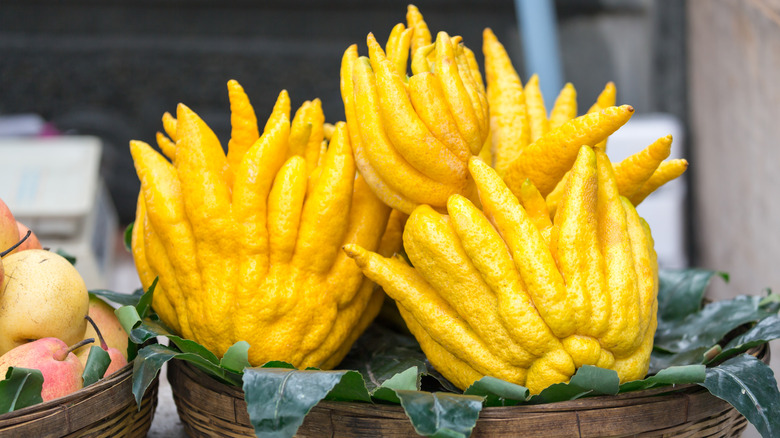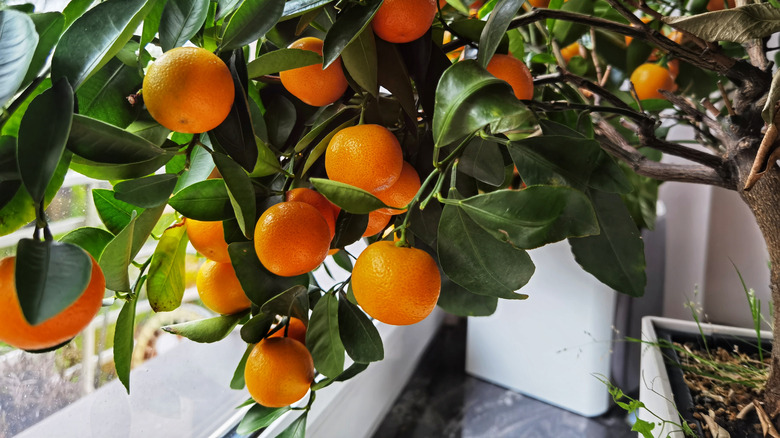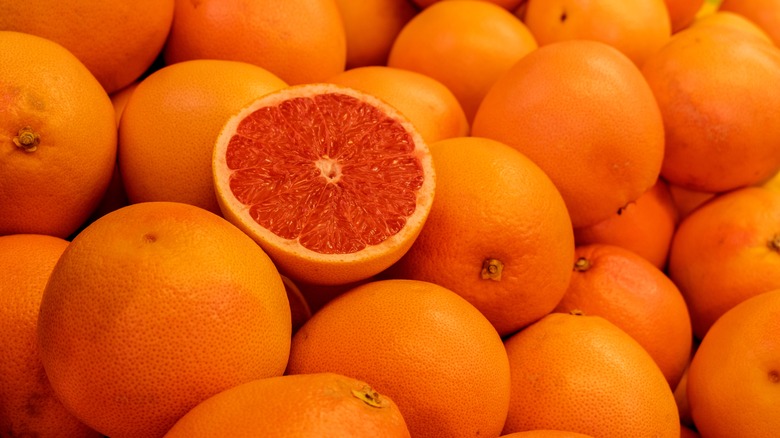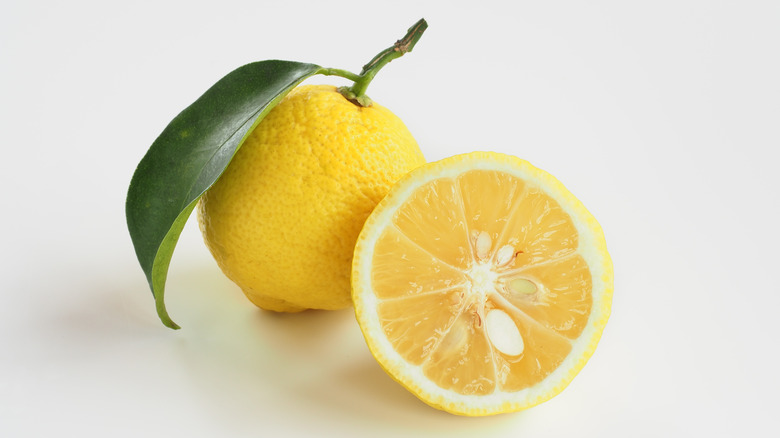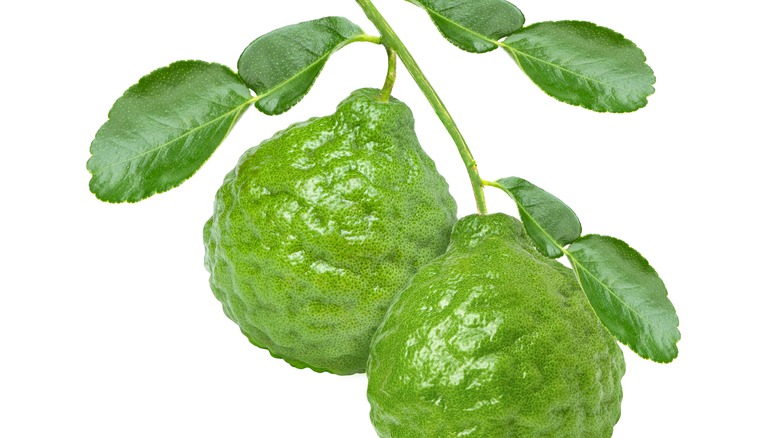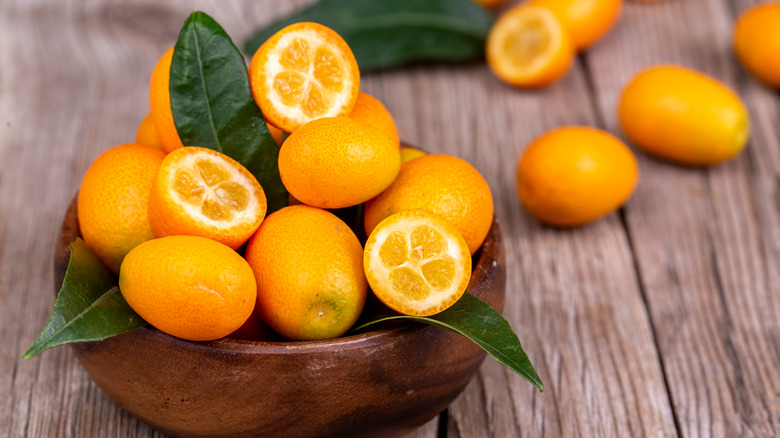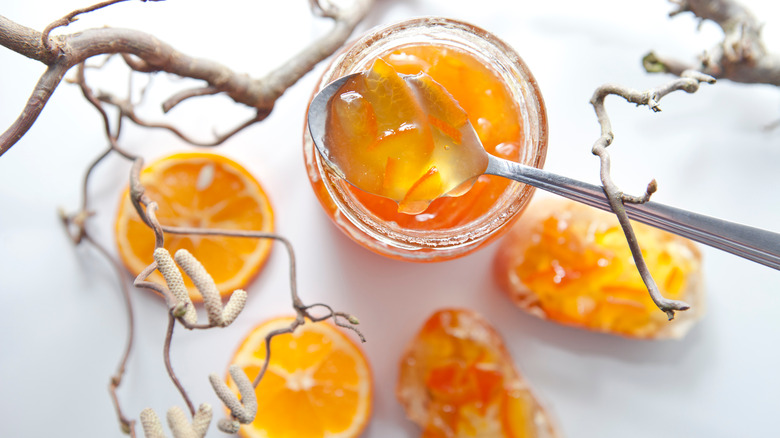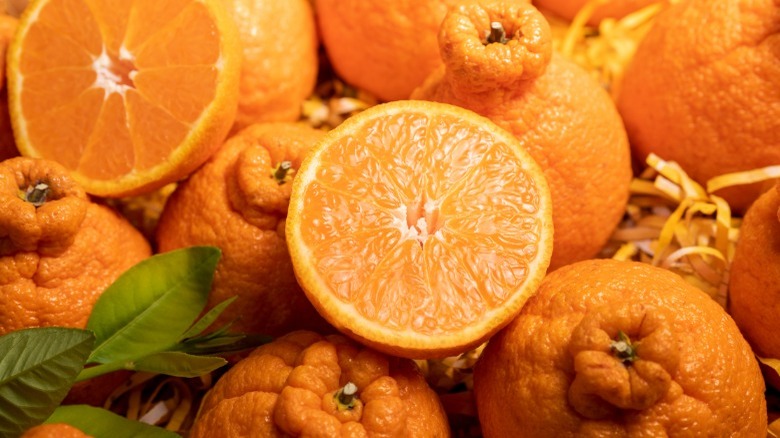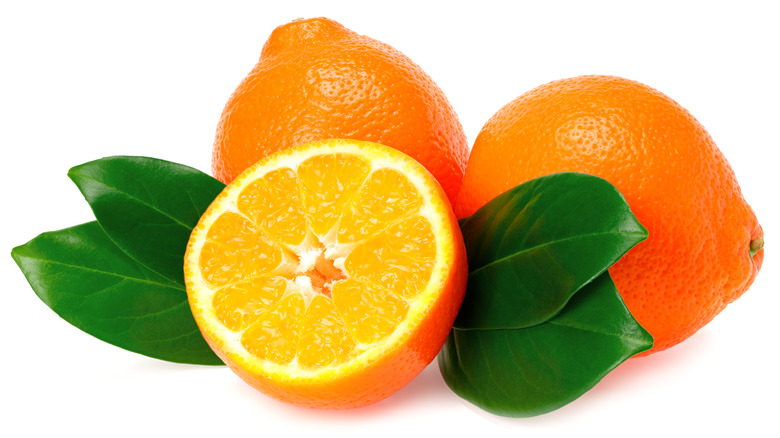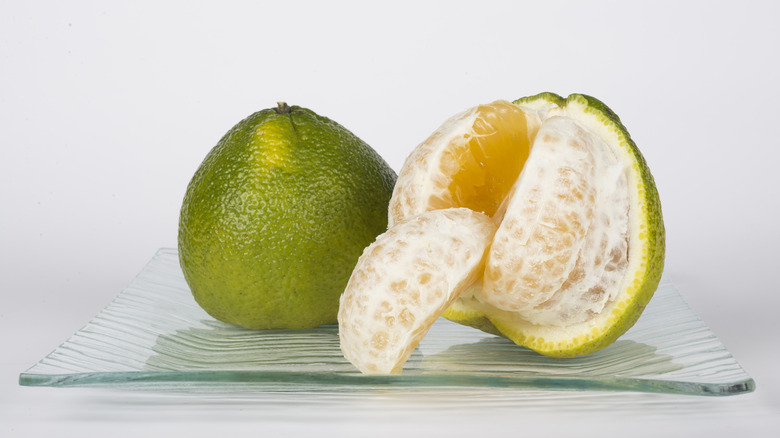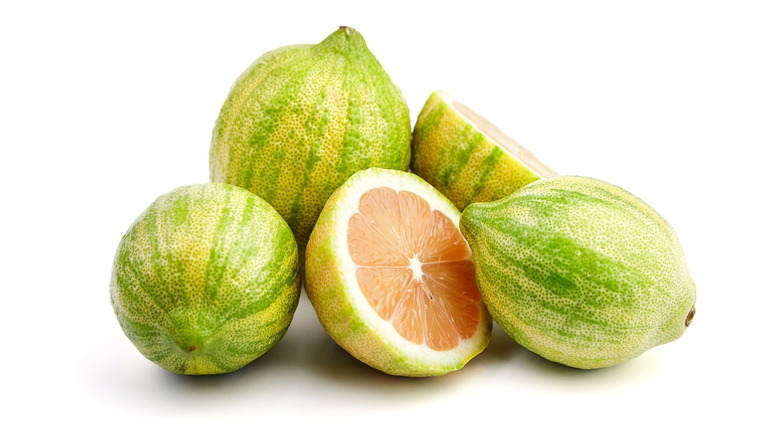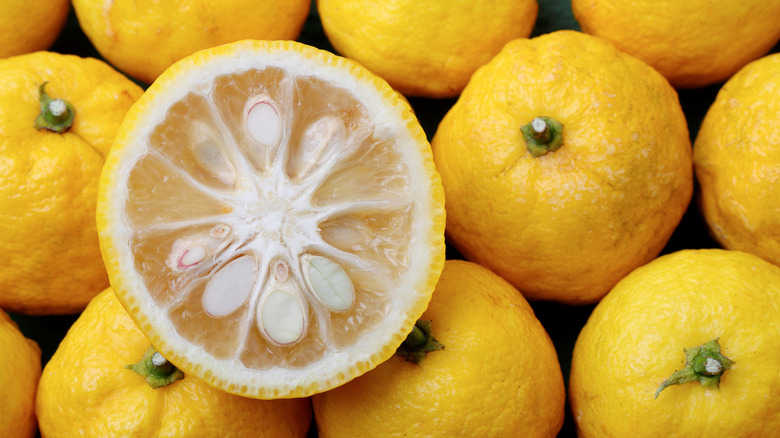13 Citrus Fruits You Might Not Have Heard Of
Welcome to citrus season. During the coldest months of the year, these sweet and sour fruits can bring a ray of sunshine into your winter recipes. And in the summer, you can celebrate that sunshine with refreshing citrus recipes that'll help you cool down. Basically, citrus fruits are great all year round.
Citrus in the United States grows in warm climates, including Florida, California, and Arizona (via eHow), but citrus is also cultivated in 140 countries around the world, providing an incredible array of flavors (via ScienceDirect). Rich in vitamins C and B, and jam-packed with antioxidants, citrus fruits can help support your immune system during cold and flu season. They also contain fiber to help keep you satiated and keep your digestion regulated.
While everyone knows about common grocery store choices like oranges, lemons, and limes, there's so much more to explore with these juicy fruits. Ranging from taste bud tantalizing tart to super syrupy sweet, citrus adds a pop of flavor and color to your meals, desserts, and drinks. Here we've gathered over a dozen kinds of citrus — some of which you may not have even heard of. Now that you're in the know, be sure to incorporate some of these varieties into your next culinary endeavor.
1. Blood orange
Why not keep the spookiness of Halloween with you all year long? With the piercing of its vivid orange rind, the blood orange reveals a succulent, deep red flesh. Despite its scary-sounding name, the chemical that gives this fruit its crimson hue and sanguine name, anthocyanin, isn't some sort of poison. In fact, this chemical is responsible for the hefty levels of antioxidants in the orange (via NPR). The brighter the colors of the fruit, the more antioxidants it contains: The insides of blood oranges can range from a deep salmon to an eye-popping magenta.
In the United States, sweet and tart moro blood oranges appear on store shelves most frequently. This variety features almost maroon-colored flesh — a visually appealing addition to any meal. On the continent, Europeans love tarocco blood oranges. These are sweeter than their more tart American cousins with a flatter colored peel and a more muted inner flesh. You might also get your hands on an appropriately named sanguinello blood orange, which houses a pinker flesh and motley yellow-red rind. However you exsanguinate it ... er, juice it, this citrus will undoubtedly delight your guests when you use it in an incredible sweet or savory blood orange recipe.
2. Buddha's hand
Often called one of the ugliest fruits on earth, Buddha's hand is a citron varietal with almost no flesh or seeds inside its spindly-fingered rind (via Smithsonian Magazine). But just because you can't juice it, doesn't mean you can't eat it. Unlike other varieties of citrus, the rind of the Buddha's hand is sweet, not bitter. For this reason, this fruit historically has been candied. Since marmalade recipes discard the inner flesh anyway, the Buddha's Hand's all-rind fingers make an ideal sweet spread. The intoxicating and strong lavender-like aroma also make it the perfect citrus variety to infuse in alcohol. Try adding the rind into a base spirit of your choice.
Outside of the kitchen, you can also use a Buddha's hand in the ancient Chinese style: as part of your laundry routine. This fragrant fruit can make your wash smell delightful — all without synthetic scents. You can even let the fruit shine as a centerpiece on your dining table. Not only will its pleasant aroma waft through the air, but the singular shape of the Buddha's Hand is sure to spark conversation.
3. Calamondin
Don't wait for the citrus harvest to come to you: grow your own fruit year-round with the calamondin. Called the "apartment orange tree," this evergreen citrus will happily thrive in a heated home, bringing the sunshine indoors (via Nature and Garden). But if it's sweet citrus you're after, look elsewhere. Calamondins are notoriously acidic. Still, if you're a sucker for a sour punch, you can sink your teeth into the small orange fruits — rind and all.
For most people, however, the calamondin is purely an ornamental citrus plant. Keep yours alive year after year by planting it in a pot with holes in the bottom to prevent root rot. Fill the bottom of the pot with rocks, gravel, or clay pebbles that ensure proper drainage, then cover the rocks with a mix of soil. Calamondins thrive when given fertilizer specific to citrus trees as it encourages more fruit growth and supports luscious green leaves.
A calamondin tree doesn't do well in harsh sunlight, so place it somewhere in your home with decent light but no direct exposure during peak hours. Your tree will happily live indoors with you during its fruit-bearing season — just be sure to keep it away from radiators and other heat sources. When the weather permits, move your potted calamondin outdoors to give it some fresh air and indirect light.
4. Cara cara
The product of a spontaneous mutation between two kinds of navel oranges, the cara cara looks and tastes different from its common orange counterparts (via Minneopa Orchards). Cara cara oranges sport the same shiny, smooth rind, but instead of the typical yellow-orange flesh, the inside of the cara cara is pinky-red, reminiscent of grapefruit. But unlike grapefruit, cara cara oranges are sweet and low in acid. They also boast hints of rose, blackberry, cranberry, and raspberry, making them unique among other citrus fruits (via Fast Growing Trees).
Enjoy a juicy cara cara on its own, or capitalize on the berry flavors by baking cranberry orange oatmeal cookies with this sweet citrus. When selecting cara caras at the store, look for fruits that feel heavy for their size. This indicates that the orange is ripe and filled with delicious juice. With higher percentages of both vitamin A and C, an orange chocolate loaf cake made with cara cara practically becomes health food. Cake for breakfast, anyone?
5. Citron
One of the original citrus fruits, the citron is the predecessor of the Buddha's hand (via Smithsonian Magazine). Like the Buddha's hand, the oversized lumpy, bumpy look of the citron betrays its pleasant and powerful fragrance. The beta-ionone in these fruits give them an additional and unexpected scent in citrus: violet (via UC Riverside). The citron is mostly rind, with only a small portion of the substantially sized fruit dedicated to the inner flesh, making it ideal for candying, marmalade, and sauces. But unlike the Buddha's hand, citrons are bitter, sour fruits, and you'll have a hard time finding them in grocery stores (via BBC).
In Calabria, Italy, however, these fruits are cultural touchstones. You can find citron-flavored ice creams, oils, cocktails, and even perfumes. Citrons also play a historical role in the Jewish holiday of Sukkot. The plant arrived in Italy not long after the Jewish migration there around 2,000 years ago, and for nearly a century the citron was the only citrus variety in Europe. Today, Jewish people from around the globe travel to Calabria in the summer to pick the fruit as part of their lulav, where they gather four plants together and use them to bless small, temporary huts constructed for the fall holiday. Even three months after being harvested, the citron's incomparable aroma still holds strong
6. Kaffir lime
Forget the fruit — focus on the leaves. While edible, kaffir limes are particularly bitter with little juice inside their bumpy, round, green skins (via Plant Food at Home). Also called makrut limes or porcupine oranges, these fruits have an intense, almost lemongrass-like taste (via U.S. Citrus). And while most people don't eat this citrus raw, it works beautifully in drinks and marmalades. You can even add some extra pizazz to your cooking with a hefty zest of its undulating rind.
The greenery surrounding the fruit is the real star of the show. A staple in Southeast Asian cuisine, kaffir lime leaves give dishes like Thai green curry and tom yum soup their distinctive lemony-limey zing. The kaffir lime leaf has two parts: a pointy-tipped upper leaflet and a broader bottom leaflet with a variegated edge. Simply remove the joint connecting the two leaf parts, and both upper and lower leaflets should easily come with it. Don't forget to remove the spine of the leaves before cutting them on the diagonal. You can use them fresh, or dry and grind them. Use this fragrant herb in the same way you would use bay leaves: Keep them in your dish while cooking but remove them before enjoying the fruits (and leaves) of your labor.
7. Kumquat
Think of the kumquat as a tiny, inverse orange. These olive-shaped citrus fruits have a soft outer skin that is far sweeter than their sour, pulpy centers (via EatDelights). For this reason, the kumquat, like the calamondin, can be eaten rind and all. An evergreen citrus, whose name in Cantonese means "golden fruit," the kumquat originated in Eastern Asia about 1,000 years ago, then made its way to Europe in the 1800s where the fruit thrived in the balmy climes of the Mediterranean (via MyParea). On the Greek island of Corfu, kumquats soon became an agricultural gold mine, and before long the Greeks had turned it into a liqueur that resembles a less sugary, less alcoholic Cointreau or triple sec.
You can snack on this sweet and tart treat raw, turn it into marmalade, add it to a pea shoots and radish salad, or even transform it into spicy kumquat salsa to accompany tilapia. And Brussels sprouts go from bland to bling when you combine them with medjool dates and sliced kumquats. However you eat it, you'll be transported to another land with the perfect citrus blend of sour and sweet.
8. Seville sour orange
You may not know this fruit by name, but you've likely tasted it, because Seville sour oranges are the marmalade citrus of choice (via Minneopa Orchards). Sometimes called the bigarade or, without its locational descriptive, the sour orange, the Seville is one of the most widely cultivated citrus varieties in the world. Filled with seeds and soft, juicy inner flesh, the sour orange traces its roots to Southeast Asia. Thanks to the Moorish migration to Europe, the bitter orange's most common name is derived from its Spanish heritage. The Seville then traveled across the Atlantic to Florida and the Caribbean where some cultivars of this acidic, tangy orange are made into the liqueur curaçao.
But Seville sour oranges aren't just for eating or imbibing. The trees themselves are also beloved for their fragrant and beautiful white and light pink flowers, and they play an essential role in helping graft sweet orange groves. In Cuba, the wood of the bitter orange tree is even used to make baseball bats and you can use the fruits and leaves of the Seville for soap as they lather exceptionally well.
9. Sumo citrus
Forget your run-of-the-mill small mandarin oranges with wimpy, thin skin. Instead, sink your teeth into sumo citrus – enormous satsuma-orange-mandarin hybrids known for their bumpy rinds and iconic top knots. With easy-to-peel, thick rinds, these super-sweet oranges make the perfect no-mess snack fruit.
Sumo citrus fruits are now grown in California's San Joaquin Valley, but this special, seedless variety originated in the 1970s in Japan where a single grower toiled for over a decade to produce these luscious yet delicate fruits. Along every step of the growing process, sumo citrus farmers treat these giant golden orbs like true treasures, hand-picking the fruit into small baskets instead of large bins, and even floating them into the assembly line where each crate is packed by hand.
To grow sumo citrus, farmers are trialing regenerative farming practices that help keep carbon in the soil of the orchards instead of in the atmosphere, along with investing in solar power. If water conservation is your concern, sumo citrus has that handled, too. Using drip irrigation and rainwater capture, both the citrus groves and the surrounding environment can thrive. Tasty and a sustainable food, sumo citrus just might become your favorite new orange.
10. Tangelo
Part pomelo and part tangerine, the tangelo is an aromatic hybrid citrus with an almost red-orange peel and waxy dark green leaves (via SFGate). Pomelos are the parent citrus variety of grapefruits, which explains the hefty size and tart taste of the tangelo. Like its cousin, sumo citrus, the tangelo also has a notable bump on top where the fruit attaches to the stem. You can enjoy this sweet-yet-sour citrus throughout the year, because tangelo trees, depending on where they're grown, can produce fruits year-round. Although there are many varieties of tangelos, one of the most popular ones, the minneola, is also often called a honeybell orange. And although this term applies only to minneolas and not all tangelo varieties, you'll likely find all kinds of tangelos referred to as honeybells.
With loose, easy-to-peel rinds and scant seeds, tangelos make a great citrus treat, no matter the season. Swap out a regular orange for a tangelo in any dish you're making. It works particularly well paired with bitter foods. Use it to add some robust color to a citrus salad, or create your own twist on a traditional lemon bar by incorporating rosemary and this delightful and tangy hybrid.
11. Ugli fruit
Deceptively named, the ugli fruit is beloved for its citrusy sweet taste and easy-to-peel rind. As a large hybrid of a mandarin orange and a grapefruit, the ugli fruit is actually a type of tangelo. But with its thick, greenish-yellow, rough, and slightly wrinkled skin, no one is likely to mistake this variety for a honeybell orange. Ugli fruits are teardrop shaped, owing to the top knot they share with other mandarin hybrids. Sometimes called uniq fruits, these perfectly nice-looking citrus come from Jamaica. The name, however, is derived from a particular brand, UGLI, whose designation became so popular that the variety itself became known as ugli, according to Healthline.
You can feast on ugli fruit like other easily peelable citrus varieties or — given its considerable size — slice it in half and eat its yellow-to-orange pulpy flesh like you would a grapefruit. This citrus cooks well in savory dishes using parsley, mint, and cilantro, and it shines on its own. Pop it in the oven on broil, and you'll caramelize the surface, sweetening up the flesh and bringing out the ugli fruit's orange, pineapple, and grapefruit flavors (via Specialty Produce). Ugli fruits can be stored in the fridge for up to two weeks, or leave them on the counter. You'll have around five days to enjoy whatever culinary delight you create.
12. Variegated pink lemon
With its charming yellow and green striped rind and pink inner flesh, you might at first glance mistake this variety of citrus for a mini watermelon. But, says Samantha Sirota, owner of Good Life Organics, an organic produce delivery service in Los Angeles, it's actually a lemon varietal. Compared to their grocery store citrus counterparts, variegated pink lemons are quite delicate and don't have a long shelf life. "While the most popular commercial varieties of lemons have a thick rind and waxy skin which holds up for weeks," Sirota tells Daily Meal. "This variegated variety has a much thinner skin. Not only does the outer skin dry out and get hard more quickly, but it's more prone to scarring," she added. The hardened outer rind, however, doesn't affect the juicy and delicious inside.
If you manage to get your hands on this specialty citrus, it likely came from a small-scale farm, like Etheridge Farm in Southern California. Because small-scale farmers don't have to go through packing houses, middlemen, and warehousing, they're better suited for growing these unique varieties of citrus than large-scale commercial producers are, adds Sirota.
13. Yuzu
Although the yuzu has a flavor that resembles grapefruit, you won't be snacking on this citrus. A fragrant, tart Japanese fruit, yuzu is most often used in Asian cuisine as a juice or a zest (via EatingWell). Yellow on the outside and the inside with large seeds, yuzu is best known for its sharp citrus flavor. Some varieties, like the Japanese yuko, are sweet, but the taste people around the world have come to love in ponzu sauce, drinks, desserts, teas, and special yuzu vinegar is more sour (via byFood). The sharp, pungent oil embedded in its rind even appears in perfumes.
Let the aroma of yuzu comfort you in cold weather: The Japanese float whole fruits in bathwater to ring in the winter solstice. You can also warm up with a shot of yuzu liqueur, which features notes of lemon and mandarin. This spirit is relatively new to Americans, but its popularity is fast growing. Give it a whirl in a Lucky Roots cocktail or a Kasai Sour. Cheers. Or should we say, kanpai!
